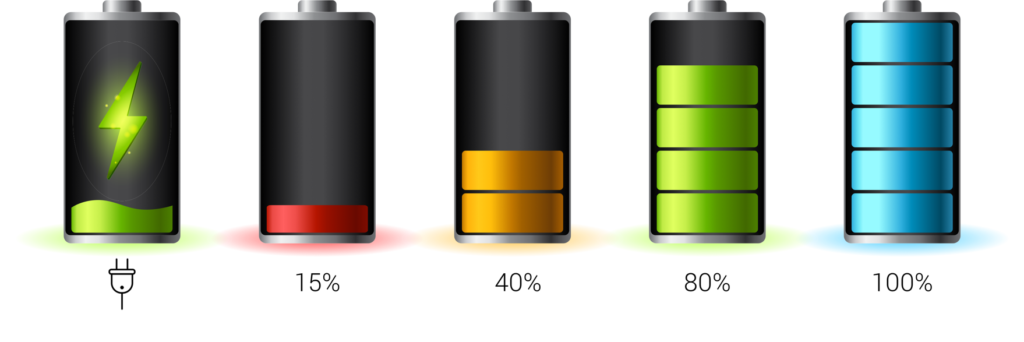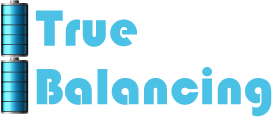TRUE BALANCING
Unlocks the Full Power of Your Batteries
We started with a single goal:
Eliminate the out-of-balance problem in lithium-ion batteries.


True Balancing is a simple, low-cost modification to your battery management electronics that can:
- Increase battery capacity between 5% and 15% 1
- Extend battery life by 20% or more 2
- Reduce the purchase cost of batteries by 5% to 10% 3
- And more… 4
It’s time to re-think what battery charge management systems are capable of.
Head-to-Head Comparison of True Balancing to Passive Balancing
Feature
True balancing
Passive balancing
Charging: How much energy can you get into the battery?
With True Balancing every cell can be brought up to true 100% SOC on every full charge cycle regardless of age of the battery or condition of the cells.
This provides the absolute maximum amount of energy that can be safely stored in any battery.
Most passive balancing systems can only charge the battery up to 80% or 90% SOC, depending on the age of the battery and the condition of the cells.
That means that between 10% and 20% of the battery’s capacity is not being used.
Discharging: How much energy can you deliver to the load?
The amount of energy that True Balancing can deliver to the load is equal to the total capacity of every cell in the battery multiplied by True Balancing’s efficiency ratio (see next row). This is the greatest possible energy that any battery/BMS combination can deliver.
The amount of battery energy that can be delivered to the load is limited by the capacity of the weakest cell in the battery.
This is the lowest possible threshold for utilization of the battery’s energy.
Efficiency: What percentage of balancing current remains in the battery?
Each transfer of energy from cell-to-cell in a True Balancing system is greater than 97% efficient. During balancing, almost all of the energy stays in the battery.
0% efficient: In passive balancing systems, 100% of the balancing current is drained from the battery and converted to heat in load resistors. This is the least efficient approach to balancing.
Speed: How quickly can the cells be balanced?
With True Balancing, maximum balancing current can be as high as you want. For most EV batteries, we recommend balancing current between 3A and 5A. The amount of time needed to complete the balancing cycle is measured in minutes rather than hours.
In passive balancing systems in EVs, balancing current is typically limited to 150mA to 250mA.
With such a small balancing current, any meaningful amount of balancing can take many hours.
Battery Life: How does the balancing system affect the life of the battery?
True Balancing completely eliminates out of balance conditions in any battery. There is no loss of capacity due to out of balance cells. This maximizes the life of the battery.
Once the cells drift out of balance past a tipping point, the battery will get further out of balance on every subsequent charge/discharge cycle.
Battery capacity steadily declines and battery life suffers.
If you would like to see how True Balancing compares to active balancing systems, please contact us.
We have white papers that compare True Balancing to three different active balancing products.
The previous table has a lot of information. Here is a shorter comparison of True Balancing to passive balancing.
This table lists the four most important features of any charging/balancing technology.
Simple Comparison of True Balancing to Passive Balancing
Feature
True balancing
Passive balancing
On every charge cycle, get as much energy into every cell as possible?
Yes
No
On every discharge cycle, deliver as much energy to the load as possible?
Yes
No
Keep the cells perfectly balanced
for the entire life of the battery?
Yes
No
Maximize the life of the battery?
Yes
No
Which technology do you want in your battery pack?
Q&A About Your Battery System

When is 100%
not 100%?

Would you accept a 1% increase in the cost of your battery pack?

Are you getting good value from your batteries?

Why aren’t you using True Balancing?
When is 100% not 100%? When your BMS says that your battery is fully charged.
Existing balancing technologies cannot bring the battery up to true 100% SOC on every charge cycle. And they cannot deliver all of the battery’s energy to the load during discharge cycles. Using existing balancing technologies with your batteries is like designing a car with a 12-gallon gas tank and limiting its use to 10 gallons. If you don’t have True Balancing in your BMS, you aren’t utilizing the full capacity of your batteries.
True Balancing is a breakthrough technology for managing charge, discharge and balancing. It yields the greatest possible battery capacity and maximizes the life of any battery — of any size, any chemistry and any architecture.
If you don’t have True Balancing, then your 100% is not true 100%.
Would you accept a 1% increase in the cost of your battery pack? True Balancing adds $80 to $90 to the battery management electronics in a typical EV. Before you think, “Wow, that’s expensive”, consider this: True Balancing can reduce the total cost of an EV battery by $500 to $1000. This stems directly from performance improvements that True Balancing provides to the battery. These performance improvements have been verified in test after test of True Balancing.
Phrased another way, would you accept a new balancing system that adds about 1% to the cost of the pack if it can reduce the total cost of the battery by 5% to 10%? What if that new BMS can add 5% to 15% to the battery’s capacity on every charge/discharge cycle? And can extend the life of the battery by 20% or more?
True Balancing can do all of this, and more. That’s a lot of added value for minimal marginal cost.
Are you getting good value from your batteries? If you aren’t using True Balancing, the answer to this question is “No”. It’s that simple.
The battery pack is far and away the most expensive component in any product that uses large batteries. If you switch to True Balancing, you can add 20% to 30% (and in some cases more) value to your battery.
Why aren’t you using True Balancing? True Balancing sets new standards for charge/discharge management systems. It uses low-cost, highly reliable switch mode technology to efficiently move energy to any cell in the battery, while monitoring changes in impedance of individual cells on a real-time basis. This unlocks an unprecedented level of control over the battery and yields information on the health of the battery on a cell-by-cell basis that existing balancing technologies are simply unable to provide.
If you’re not convinced yet, please keep reading. The remainder of this site explains how True Balancing works, how True Balancing can improve the performance of your batteries and how True Balancing can lower the cost of your battery packs.
Other Pages On This Site
Want to Learn More About True Balancing?


What It Does
Learn more about benefits that
True Balancing brings to batteries


How It Works
See a circuit diagram and logic
flowchart that illustrate how
True Balancing works


How To Use It
True Balancing is designed
for easy system integration
and low-cost mass-production


Development History
The history of True Balancing
from our first proof-of-concept
to the current Gen 3 system


Articles & Papers
Take a deeper dive
into True Balancing

